Anatomy of a Pressure Gauge
How a bourdon pressure gauge works
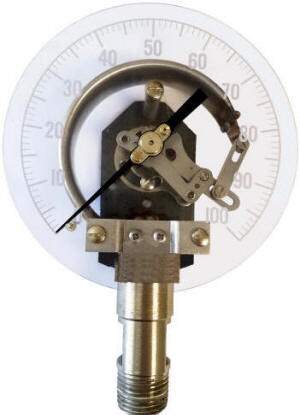
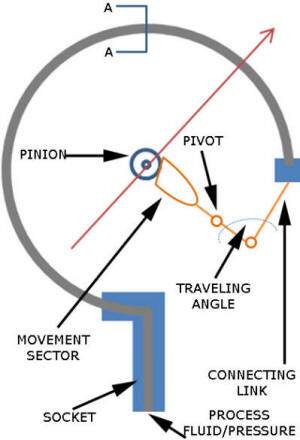
Pressure gauges are
commonplace and used to indicate the pressure of a pipeline, but do you know
how they work and why there seems to be large differences in pricing for
what appears to the same product?
The importance of a
pressure gauge is often overlooked. A well-designed and properly sized
pressure gauge should provide accurate service for years. The
performance of spray nozzles, pumps and other fluid components are evaluated
by pressure gauges in the fluid system. A quality pressure gauge will
pay for itself by increasing the accuracy and control of your process.
Since the Bourdon
tube style is the most commonly used design, this article will focus on
Eugene Bourdon's invention over 175 years ago.
The basic operating
principle of a Bourdon tube gauge is a hollow, C-shaped tube which is opened
to pressure at one end and welded shut at the other. When the tube is
pressurized it tries to straighten-out, moving attached linkage and a
pointer to indicate the precise pressure. The design of the Bourdon
tube, having a curvature and thus the inside radius being less than the
outside radius makes it possible to correlate the movement of the tube to a
specific pressure.
Peel-off the case to see what is inside!
Actually, starting
with the case is a good beginning. The outer case of a gauge is
typically made from plastic, painted or plated steel, brass or - most
commonly - stainless steel. Some cases are designed to be opened for
servicing the gauge, but most are not, so you never get to see what is
inside. The complexity of the case is the first indication of cost; a
case designed to allow a glycerin/silicon fill needs to seal to prevent
leakage and thus is slightly more complex/expensive than a "dry" gauge that
is not "fillable". Likewise, some gauge cases are made with a solid
front so in the event of a catastrophic internal failure the process fluid
is directed backwards and presumably away from personnel. Finally,
cases can be designed for mounting within panels or simply mounted to the
fluid system.
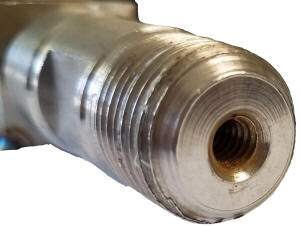 The
pressure gauge socket (inlet) is the first part of the gauge the process
fluid contacts, unless you are isolating it with a diaphragm seal.
Inexpensive gauges simply have a hole drilled into the inlet connection,
more expensive gauges have a threaded hole, in which can be installed a
restrictor orifice. A removable restrictor orifice provides two basic
functions, slight dampening of the inlet surge and protecting the internals
of the gauge from particles that can become embedded within the Bourdon
tube, causing it to malfunction. If some foreign material becomes
caught on the orifice, it can easily be removed, however once material
becomes lodged within the Bourdon tube the likelihood of removing it is
slim.
The
pressure gauge socket (inlet) is the first part of the gauge the process
fluid contacts, unless you are isolating it with a diaphragm seal.
Inexpensive gauges simply have a hole drilled into the inlet connection,
more expensive gauges have a threaded hole, in which can be installed a
restrictor orifice. A removable restrictor orifice provides two basic
functions, slight dampening of the inlet surge and protecting the internals
of the gauge from particles that can become embedded within the Bourdon
tube, causing it to malfunction. If some foreign material becomes
caught on the orifice, it can easily be removed, however once material
becomes lodged within the Bourdon tube the likelihood of removing it is
slim.
The body of the
socket and especially how the Bourdon tube is welded to the socket is
critical to a long-lasting pressure gauge; you want quality materials and
quality welding.
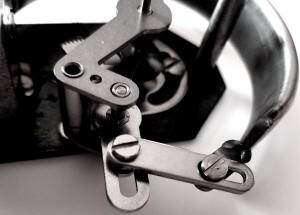
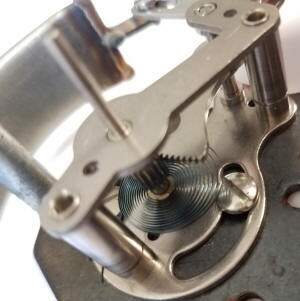 Welding
style and quality equally applies at the closed end of the Bourdon tube,
where the linkage is attached. A pivot point to which a geared
movement is attached is connected to the linkage on the other side, thus as
the Bourdon tube "flexes", the angle of the linkage moves the geared
movement.
Welding
style and quality equally applies at the closed end of the Bourdon tube,
where the linkage is attached. A pivot point to which a geared
movement is attached is connected to the linkage on the other side, thus as
the Bourdon tube "flexes", the angle of the linkage moves the geared
movement.
These internals are
protected from moisture or an aggressive environment when the gauge is
filled with glycerin or silicon. The gauge quality and its cost are a
reflection of these internal components. For example, machined
components are often of higher quality and have more "endurance" than less
expensive stamped components because they need to be thicker to machine.
The geared movement rotates the pointer to the corresponding scale on the
gauge dial (face), thus finer gears equate to increased accuracy. The
materials used are also an indication of quality; stainless steel components
will often outlast copper alloy parts.
The pointers
themselves vary in complexity. Some like the one picture here enable fine
adjustments to compensate for altitude or wear caused by pulsations and
vibration.
![]()
![]()
Pointers can also
trigger separate high and low pressure pointers affixed to the gauge window
to record extreme conditions when incorporating a pressure transducer is not
possible.
The pressure gauge
dial has a scale that is calibrated to the Bourdon tube, if you want, the
dial can be customized with a company name, logo or colors - such gauges
incur an artwork charge and have 10+ weeks lead-time associated with them.
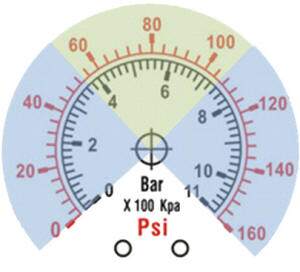 Pressure
Gauge Accuracy
Pressure
Gauge Accuracy
You will often see
the accuracy of a pressure gauge expressed as "3-2-3% ASME B40.1 Grade B" or
"2-1-2% ASME B40.1 Grade A" and this refers to the accuracy for each third
of the dial scale. Therefore, the 1st and 3rd
sections of the dial are the least accurate and the middle portion of the
gauge is most accurate. When selecting a pressure gauge try to choose
a scale such that your normal operating pressure will fall within the middle
portion of the range to maximize accuracy. Some gauges offer
accuracies of 1% of full scale (FS) which means it is 1% accurate anywhere
on the dial.
The last piece of a
gauge is its window, which protects the pointer and gauge internals from
the surrounding environment. A gauge window can be made of glass, tempered
glass and hard or soft plastic. Soft plastic windows are often
referred to as thermal compensating because they flex, allowing for
glycerin/silicon fill to expand without bleeding from the gauge case.
This is also why filled gauges usually have an air bubble towards the top,
allowing for expansion due to heat or altitude.
With an understanding
of how a Bourdon tube gauge works, the components involved and accuracy you
are empowered to select the most appropriate pressure gauge for your product
or application.



